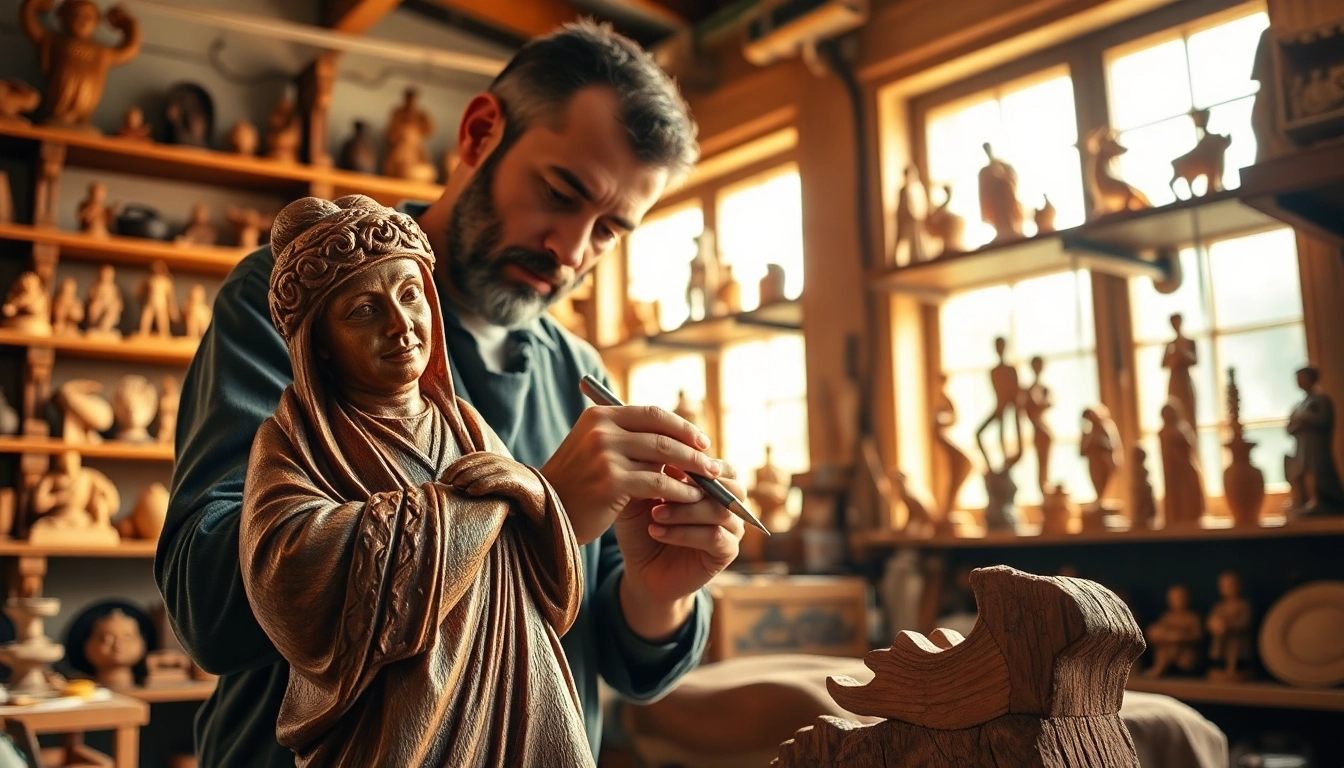Mastering the Art of Olive Wood Carvings: Tradition Meets Craftsmanship
Understanding Olive Wood Carvings
Olive wood carvings represent a timeless craftsmanship that originates from the olive groves of the Middle East, specifically the regions surrounding Bethlehem and Jerusalem. Known for their intricate designs and religious significance, these carvings create a unique blend of art and heritage, appealing to collectors and spiritual individuals alike. The beauty of olive wood carvings lies in their natural textures and colors, which evoke a sense of history, craftsmanship, and spirituality. The exquisite nature of olive wood carvings has inspired artisans for centuries, making them a sought-after medium for artistic expression and religious dedication.
What Are Olive Wood Carvings?
Olive wood carvings are artistic creations made from the wood of the olive tree, which is revered not only for its fruit but also for its durable and beautifully grained wood. Artisans skillfully carve this wood to create a variety of items, including sculptures, nativity scenes, crosses, and decorative pieces. Each piece is a testament to both the natural beauty of the wood and the craftsmanship of the artist. The dark and light streaks found in the grain of the wood contribute to the uniqueness of each carving, creating one-of-a-kind artworks that often carry deep religious or cultural significance.
The Cultural Significance of Olive Wood
Olive wood has a profound cultural significance, particularly in Christian traditions. The olive tree is frequently mentioned in the Bible, symbolizing peace, prosperity, and the presence of God. It is believed that the wood holds a sacred connection to the Holy Land, making olive wood carvings not just decorative items but also spiritual relics. The production of these carvings supports local communities and preserves artisan traditions that have been passed down through generations. Given their rich cultural background, these carvings often serve as powerful gifts representing faith and communion.
Regions Known for Olive Wood Carvings
The most prominent region for olive wood carving is Bethlehem, a town renowned for its long-standing tradition in this craft. Local artisans, often belonging to Christian communities, utilize their woodworking skills handed down from their ancestors to create stunning olive wood pieces. Other regions within Palestine, including Jerusalem and surrounding areas, also contribute to this vibrant craftsmanship. The distinctive styles vary slightly from one artisan to another, reflecting individual artistic expressions while maintaining the traditional techniques that characterize olive wood carvings.
The Craftsmanship Behind Olive Wood Carvings
Materials Used in Olive Wood Carvings
Olive wood is prized for its density, durability, and beauty. The wood comes from the trunk and branches of the olive tree, with each piece providing a different hue and grain pattern. The trees, often centuries old, yield wood that has a rich color palette, ranging from golden yellows to deep browns. This variance in color enhances the appeal of carvings, as artisans design each piece to showcase the natural beauty of the grain. Additionally, the wood’s natural oils provide a level of moisture resistance, making it suitable for various climates.
Techniques and Tools for Carving
The techniques used in olive wood carving are traditional and labor-intensive. Artisans employ hand tools such as chisels, knives, and gouges to shape the wood, relying on their skills and experience rather than modern machinery. The process begins with selecting the right piece of wood, taking into account its grain and density. Artists then sketch designs onto the wood’s surface before carefully chiseling away excess material to reveal the final form. This process can take hours or even days, depending on the complexity of the design, but the craftsmanship is evident in every piece.
Notable Artisans and Their Styles
Throughout the years, certain artisans have distinguished themselves through their unique styles and approaches to olive wood carving. These individuals often create signature pieces that become celebrated for their detail and religious themes. Artisans like Jamil Abu Zaid demonstrate an unparalleled ability to harness the natural features of the wood to create lifelike figures, while others may focus on abstract forms or traditional religious symbols. Each artist’s style contributes to the rich tapestry of olive wood carving, making the work of each craftsman significant in its own right.
Choosing Quality Olive Wood Carvings
Identifying Authentic Olive Wood Products
When purchasing olive wood carvings, authenticity is key. Genuine olive wood carvings will exhibit a rich, varied grain, with no synthetic materials present. Buyers should look for small imperfections or variations, as these indicate handmade craftsmanship rather than mass production. Trusted vendors often provide a certification of authenticity or provenance, confirming the origin of the wood and the artisan’s background. Engaging with local artisans or reputable retailers can further ensure the quality and authenticity of olive wood products.
Key Features to Look for in Quality Carvings
Quality olive wood carvings share certain characteristics that distinguish them from lower-grade products. Look for clarity in detail, smoothness in the finish, and vibrant coloring. The carving’s design should be cohesive and intentional, with attention to proportion and style. Moreover, the piece should feel sturdy; exceptionally light or overly fragile items may indicate the use of inferior wood or techniques. Understanding these traits can help ensure that collectors and buyers are investing in well-crafted artworks.
Common Mistakes When Purchasing Olive Wood Items
Many buyers may make mistakes when purchasing olive wood carvings, often due to a lack of knowledge about what constitutes quality. One common error is not verifying the provenance of the wood. Buyers should avoid products labeled as “olive wood” if they cannot confirm their source, as imitations made from other wood types are prevalent in the market. Additionally, not considering the size and intended display of the carving can lead to disappointment, especially if buyers neglect to account for the piece’s scale in their living space. Lastly, failing to ask about care instructions may affect the long-term quality of the carving.
Care and Maintenance of Olive Wood Carvings
Cleaning and Caring for Your Carvings
Maintaining the beauty of olive wood carvings requires proper care. Regularly dusting the carvings with a soft, dry cloth will help prevent the accumulation of dirt and oils. For more thorough cleaning, gentle soap and water can be used, followed by drying immediately with a soft cloth to prevent moisture from seeping into the wood. Avoiding chemical cleaners is vital, as they can strip the natural oils that protect the wood and may lead to discoloration or damage over time.
Protecting Olive Wood from Damage
To protect olive wood carvings from damage, it’s critical to avoid exposing them to direct sunlight and extreme temperatures, which can cause the wood to dry out or fade. Placing carvings in a stable environment with moderate humidity is beneficial. Additionally, applying food-safe mineral oil occasionally can help enhance and preserve the wood’s natural luster. Owners should also be cautious about using sharp objects near the carvings to avoid scratches that can diminish their aesthetic appeal.
When to Seek Professional Restoration
Over time, olive wood carvings may require professional restoration due to wear, damage, or environmental impact. Signs that it’s time to consult an expert include noticeable cracks, significant scratches, or fading of the wood’s color. A professional can assess the carving and apply appropriate restoration techniques, which can involve refinishing surfaces or repairing damage without compromising the integrity of the piece. Seeking professional help is often worthwhile for valuable or cherished items, ensuring they remain in excellent condition for years to come.
Gifting and Displaying Olive Wood Carvings
Creative Ways to Gift Olive Wood Art
Olive wood carvings make meaningful gifts for a variety of occasions. When gifting, consider the recipient’s tastes and interests; for instance, a beautifully carved nativity scene can hold special significance for someone of faith. Presenting a carved piece in a way that highlights its beauty—such as through elegant wrapping or accompanying a personalized note—can enhance the gifting experience. Additionally, consider how the piece can be further personalized with engravings or customized designs that resonate with the recipient’s personal beliefs or aesthetics.
Best Practices for Displaying Your Carvings
Display plays an essential role in showcasing the beauty of olive wood carvings. Placement should prioritize visibility while also considering light exposure and environmental factors. Ideally, carvings should be displayed in well-lit areas, such as shelves or mantels, where natural light enhances their intricate details without risking direct sunlight. Consider using display cases that provide some protection while still allowing for appreciation of the artwork. Grouping smaller pieces can create a visually appealing arrangement, highlighting the diversity and craftsmanship involved in olive wood carving.
Incorporating Olive Wood into Home Decor
Olive wood carvings can seamlessly blend into various home decor styles, enhancing interior spaces with their warmth and character. From rustic farmhouses to chic modern homes, olive wood can complement and elevate design aesthetics. Incorporating carved pieces into various settings, such as centerpieces for dining tables or accent pieces in living rooms, allows for versatile use of the art. Layering olive wood items with other materials—such as metal or glass—can create inviting contrasts and depth in design, making olive wood an excellent choice for enriching home environments.














Post Comment